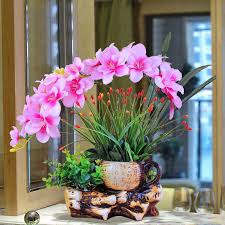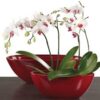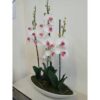# Choosing the Right Pot for Phalaenopsis Orchids: A Comprehensive Guide

Phalaenopsis orchids, commonly known as moth orchids, are popular among plant enthusiasts for their stunning flowers and relative ease of care. One critical aspect of successfully cultivating these beautiful orchids is selecting the right pot. The choice of pot can significantly impact the health and growth of your plants. This guide will cover essential considerations for choosing the perfect pot for Phalaenopsis orchids, ensuring they thrive in your care.
## Table of Contents
1. **Introduction to Phalaenopsis Orchids and Potting**
– 1.1 Overview of Phalaenopsis Orchids
– 1.2 Importance of Potting for Orchid Health
2. **Understanding Orchid Potting Needs**
– 2.1 Unique Root Structure of Orchids
– 2.2 Watering and Drainage Requirements
3. **Types of Pots for Phalaenopsis Orchids**
– 3.1 Plastic Pots
– 3.2 Clay Pots
– 3.3 Decorative Pots and Planters
4. **Choosing the Right Size Pot**
– 4.1 Importance of Pot Size
– 4.2 Signs Your Orchid Needs a Bigger Pot
– 4.3 How to Measure Pot Size Correctly
5. **Potting Materials: Pros and Cons**
– 5.1 Plastic vs. Clay vs. Ceramic
– 5.2 Environmental Impact of Pot Materials
– 5.3 Choosing Sustainable Options
6. **Drainage: Key to Healthy Orchids**
– 6.1 Importance of Proper Drainage
– 6.2 How to Ensure Good Drainage
– 6.3 Drainage Holes: Size and Placement
7. **Using Potting Media Effectively**
– 7.1 Best Potting Mixes for Phalaenopsis Orchids
– 7.2 How to Choose the Right Mix
– 7.3 When to Refresh Potting Media
8. **Repotting Your Phalaenopsis Orchid**
– 8.1 When to Repot
– 8.2 Step-by-Step Repotting Guide
– 8.3 Aftercare Post-Repotting
9. **Common Mistakes in Pot Selection**
– 9.1 Choosing the Wrong Size
– 9.2 Ignoring Drainage Needs
– 9.3 Failing to Consider Pot Material
10. **Conclusion: Thriving with the Right Pot**
– 10.1 Recap of Key Points
– 10.2 Encouragement for Orchid Enthusiasts
—
## 1. Introduction to Phalaenopsis Orchids and Potting
### 1.1 Overview of Phalaenopsis Orchids
Phalaenopsis orchids are among the most popular orchids due to their stunning blooms, long-lasting flowers, and relatively easy care requirements. Native to Southeast Asia, these orchids thrive in warm, humid environments, making them ideal houseplants.
### 1.2 Importance of Potting for Orchid Health
Choosing the right pot is crucial for the health of Phalaenopsis orchids. A suitable pot provides the necessary support for roots, proper drainage, and sufficient space for growth. Understanding the unique potting needs of orchids is essential for promoting vibrant blooms and overall plant vitality.
## 2. Understanding Orchid Potting Needs
### 2.1 Unique Root Structure of Orchids
Orchid roots are different from those of other houseplants. They are thick, fleshy, and designed to absorb moisture and nutrients from the air and the potting medium. This unique structure requires specific considerations when selecting a pot.
### 2.2 Watering and Drainage Requirements
Phalaenopsis orchids prefer to dry out slightly between waterings. Therefore, a pot with adequate drainage is essential to prevent root rot. Understanding how water interacts with potting media and pots will help you create an optimal growing environment.
## 3. Types of Pots for Phalaenopsis Orchids
### 3.1 Plastic Pots
Plastic pots are lightweight, affordable, and retain moisture well. They are ideal for beginners and are often used for commercial orchids. Ensure the pot has drainage holes to prevent water accumulation.
### 3.2 Clay Pots
Clay pots are porous and allow for better airflow to the roots, which helps prevent rot. They tend to dry out faster than plastic pots, so they require more frequent watering.
### 3.3 Decorative Pots and Planters
While decorative pots can enhance the aesthetic of your home, ensure they have adequate drainage. Consider using a decorative outer pot with a proper inner pot that provides the right environment for your orchid.
## 4. Choosing the Right Size Pot
### 4.1 Importance of Pot Size
The size of the pot is crucial for the healthy growth of Phalaenopsis orchids. A pot that is too small can restrict root growth, while a pot that is too large may retain excess moisture, leading to root rot.
### 4.2 Signs Your Orchid Needs a Bigger Pot
Common signs that your orchid needs repotting include:
– Roots are growing out of the pot or through drainage holes.
– The plant appears top-heavy and unstable.
– The potting medium is breaking down or compacted.
### 4.3 How to Measure Pot Size Correctly
To measure pot size, consider the diameter and depth. Generally, choose a pot that is 1-2 inches larger in diameter than the current pot. Ensure the depth is sufficient to accommodate the root system without crowding.
## 5. Potting Materials: Pros and Cons
### 5.1 Plastic vs. Clay vs. Ceramic
– **Plastic Pots:** Lightweight, retain moisture, but may not provide adequate aeration.
– **Clay Pots:** Good for airflow and drainage, but heavier and can dry out quickly.
– **Ceramic Pots:** Attractive but often lack drainage; ensure they have holes if used.
### 5.2 Environmental Impact of Pot Materials
Consider the environmental impact of your chosen pot materials. Look for pots made from recycled materials or sustainable options to reduce your carbon footprint.
### 5.3 Choosing Sustainable Options
Explore eco-friendly potting options, such as biodegradable pots made from natural materials. These can provide the necessary support for your orchids while being kind to the environment.
## 6. Drainage: Key to Healthy Orchids
### 6.1 Importance of Proper Drainage
Good drainage is vital for preventing root rot and ensuring healthy growth. Orchids are susceptible to overwatering, so choosing a pot that promotes drainage is essential.
### 6.2 How to Ensure Good Drainage
– **Use Pots with Holes:** Ensure your pot has multiple drainage holes.
– **Elevate Pots:** Place pots on pot feet or a surface that allows for airflow underneath.
### 6.3 Drainage Holes: Size and Placement
Drainage holes should be adequately sized and distributed evenly to allow for effective water runoff. Larger holes facilitate faster drainage, which is beneficial for Phalaenopsis orchids.
## 7. Using Potting Media Effectively
### 7.1 Best Potting Mixes for Phalaenopsis Orchids
Phalaenopsis orchids thrive in well-draining potting mixes. Recommended mixes include:
– **Bark Mix:** Made from pine bark, it offers excellent drainage and aeration.
– **Sphagnum Moss:** Retains moisture while providing adequate airflow.
– **Coconut Coir:** Sustainable and offers good drainage.
### 7.2 How to Choose the Right Mix
Consider your growing conditions and how often you water your orchids when choosing a potting mix. If you live in a dry climate, a mix that retains moisture may be beneficial.
### 7.3 When to Refresh Potting Media
Refreshing your potting media every 1-2 years helps maintain a healthy growing environment. Signs that it’s time to refresh include compacted media or a decline in plant health.
## 8. Repotting Your Phalaenopsis Orchid
### 8.1 When to Repot
Repot your Phalaenopsis orchid every 1-2 years or when you notice signs of root crowding or media breakdown. Early spring is an ideal time for repotting, as it coincides with the growing season.
### 8.2 Step-by-Step Repotting Guide
1. Carefully remove the orchid from its pot.
2. Inspect the roots, trimming any dead or damaged areas.
3. Place the orchid in a new pot with fresh potting media, ensuring the crown is above the media level.
4. Water lightly and place the orchid in a shaded area for a few days.
### 8.3 Aftercare Post-Repotting
After repotting, provide your orchid with slightly reduced light and water it sparingly to allow the roots to adjust. Monitor the plant closely for any signs of stress.
## 9. Common Mistakes in Pot Selection
### 9.1 Choosing the Wrong Size
Selecting a pot that is too small or too large can hinder your orchid’s growth. Ensure you choose the appropriate size based on your orchid’s needs.
### 9.2 Ignoring Drainage Needs
Failing to provide adequate drainage can lead to overwatering and root rot. Always prioritize pots with good drainage.
### 9.3 Failing to Consider Pot Material
Ignoring the properties of different pot materials can impact your orchid’s health. Consider factors such as moisture retention, aeration, and weight when choosing a pot.
## 10. Conclusion: Thr
iving with the Right Pot
### 10.1 Recap of Key Points
Choosing the right pot for Phalaenopsis orchids is a critical aspect of their care. Key considerations include pot size, drainage, material, and potting media.
### 10.2 Encouragement for Orchid Enthusiasts
With the right pot and proper care, Phalaenopsis orchids can flourish and provide stunning blooms. Embrace the joy of orchid cultivation and enjoy the beauty these plants bring to your home.
—

